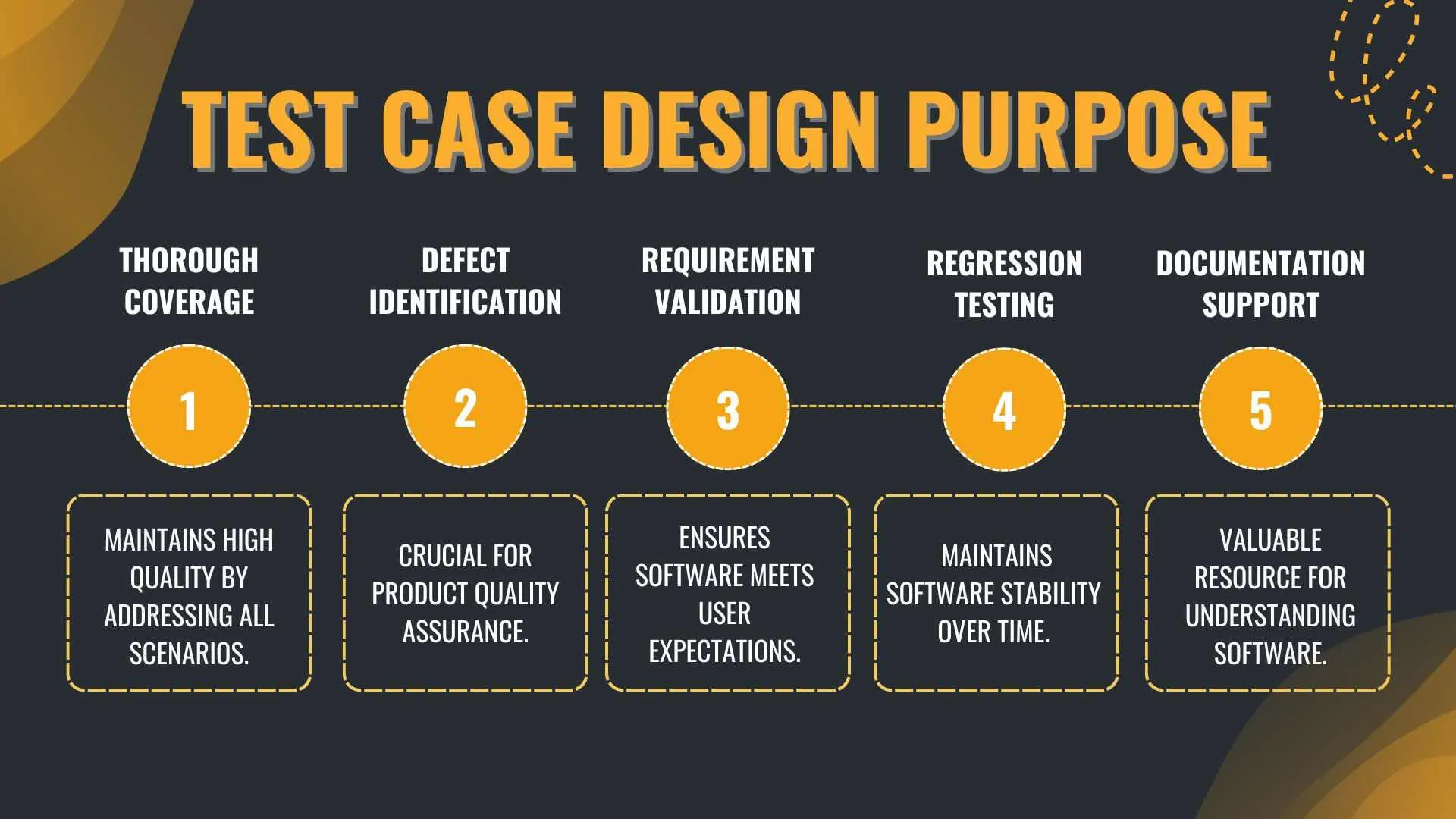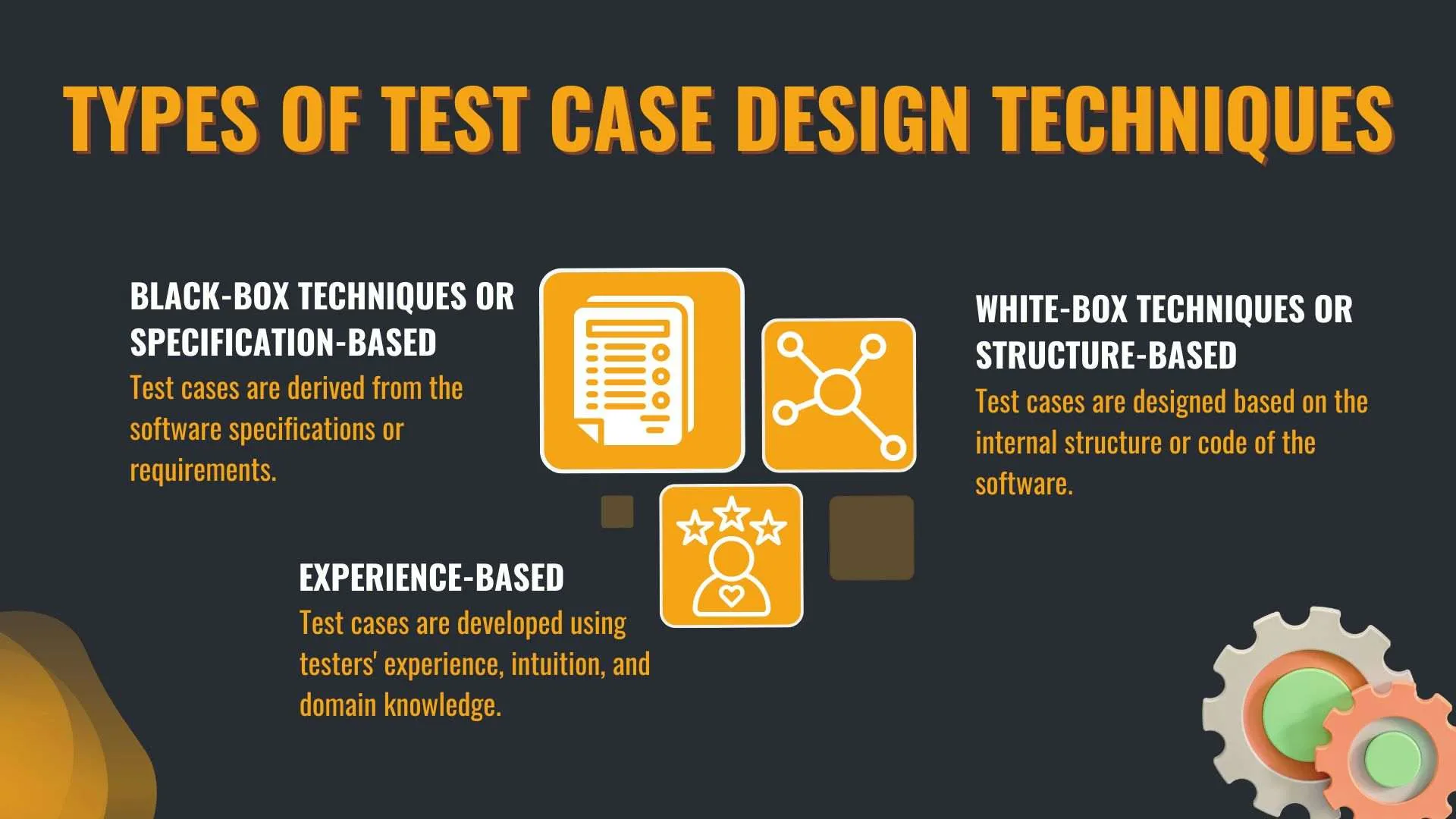In the software industry, offering an excellent software product is very important. Test case design is a key component of quality assurance. Test cases act as the fundamental units for testing software functionalities, ensuring they meet the specified requirements and perform as intended. To enhance the efficiency of software testing, let us explore the most efficient practices for test case design, using the latest methods and trends. 🚀
Test case design is crucial for the testing process, providing a systematic approach to verifying software functionality and reliability. It involves creating detailed plans or test cases that outline steps, inputs, and expected outcomes for both manual and automated testing. This process occurs alongside coding and unit tests in the software development lifecycle, driven by user stories and software requirements. 🔍
A good test case should fit the testing plan and take the user interface into account. It looks at both how things work and how they perform, using a mix of hands-on and automated methods. 🌟 Using automation tools helps speed things up and handle bigger tasks, but it's important to find the right balance between manual and automated testing. ⚖️
📌Understanding Test Case Design: Test case design is fundamental to software testing, ensuring comprehensive coverage and reliability.
📌Purpose and Importance: Test case design serves the crucial purpose of verifying software functionality and meeting user requirements.
📌Planning and Design Process: Effective test case design involves meticulous planning, scenario identification, input definition, and outcome specification.
📌AI Integration: AI revolutionizes test case generation, streamlining the process and enhancing testing efficiency.
📌Collaboration with Stakeholders: Collaborating with stakeholders enhances test case design by incorporating diverse perspectives and aligning with business objectives.
📌Emerging Trends: Stay updated on emerging trends in test case design to leverage the latest advancements and improve testing practices.
What is Test Case Design?
At its core, test case design involves creating detailed plans for testing various aspects of a software application. 📝 It encompasses identifying test scenarios, determining test inputs, executing test procedures, and defining expected outcomes. 🧪

This meticulous process ensures that the software undergoes rigorous testing activities, covering everything from integration testing to performance testing. 🚀 It also considers boundary conditions and employs techniques like boundary value analysis to uncover potential issues. 💡

Moreover, test case design accounts for human error and is the critical aspect of continuous testing in an agile methodology. 🔄 Transition testing ensures smooth transitions between different phases, while the testing environment provides the necessary infrastructure for testing processes to thrive. 🌐

What is the purpose of test case design?
Test case design serves several purposes, including:
- Ensuring thorough test coverage across different functionalities is essential for maintaining high software quality standards. 🎯 This involves analyzing user requirements and input conditions to design comprehensive test cases that address all possible scenarios. 📋
- Identifying defects and vulnerabilities in the software is crucial for product quality assurance. By conducting strict testing activities and utilizing automation frameworks, teams can uncover potential issues before they impact end users. 🔍
- Validating that the software meets specified requirements ensures that it aligns with user expectations and quality standards. ✅ Through requirements analysis and real-world scenario testing, valuable insights are gained into the software functionality and performance. 💡
- Facilitating regression testing to ensure new changes do not adversely impact existing features is essential for maintaining software stability over time. 🔄 This helps prevent unexpected behaviour and ensures a smooth transition to updated versions, ultimately reducing time to market. ⏰
- Providing documentation for future reference and maintenance is key to supporting ongoing software development efforts. 📄 Detailed documentation, created in collaboration with product owners and stakeholders, serves as a valuable resource for understanding the software's functionality and network connection requirements. 📡

Basic Example of Test Case Design
Consider a scenario where you need to test the login functionality of a web application. A basic test case design for this scenario might include:
- Title: Test for Checkout Process with 1 Item in Cart
- Description: Verify users can complete checkout and payment without issues
- Preconditions: The user is logged in
- Assumptions: The user is using a supported device/browser
- Test Steps:
- Open the app/website
- Navigate to a product
- Add the product to the cart
- Proceed to checkout
- Enter address details
- Provide payment information
- Complete checkout
- Expected Result: The checkout process is successful with confirmation received.
- Actual Result: Pass = If the checkout has successfully completed, Fail = If the checkout functionality has failed
Use of AI in Test Case Generation
The use of AI in test case generation is revolutionizing the way we approach software testing. 🤖 By leveraging advanced algorithms and machine learning techniques, AI-powered tools can automate the creation of test cases, significantly reducing manual effort and enhancing efficiency.
AI can analyze vast amounts of data to identify patterns, predict potential edge cases, and prioritize test scenarios based on their relevance and impact. This not only speeds up the test case generation process but also ensures comprehensive coverage across different aspects of the software.📊

Moreover, AI-driven test case generation can adapt to changes in the software over time, dynamically adjusting test suites to accommodate new features or functionalities. This agility is invaluable in today's fast-paced software development lifecycle (SDLC), where continuous integration and delivery are the norms. ⚙️

How to Plan and Design Test Cases?
Effective test case design begins with comprehensive planning. Here are some steps to guide you through the process:
- Understand Requirements: Gain a thorough understanding of the software requirements and functionalities to be tested. 📝
- Identify Test Scenarios: Enumerate the various scenarios that need to be tested, including positive, negative, and edge cases. 🔄
- Define Test Inputs: Determine the inputs required to execute each test scenario, including data inputs, environment configurations, and user actions. 🎛️
- Create Test Procedures: Develop detailed test procedures outlining the steps to be followed for each test scenario. 📋
- Specify Expected Outcomes: Clearly define the expected outcomes or behaviours for each test scenario to validate whether the software behaves as intended. ✅

Different Types of Test Case Design
Test case design can vary based on the testing objectives and methodologies. Some common types of test case design include:
- Functional Testing: Focuses on testing individual functions or features of the software. 🧩
- Integration Testing: Verifies the interactions between different components or modules of the software. 🔄
- Regression Testing: Ensures that recent code changes have not adversely affected existing functionalities. 🛠️
- Usability Testing: Evaluates the user-friendliness and intuitiveness of the software interface. 👩💻
- Performance Testing: Tests the responsiveness, scalability, and stability of the software under various load conditions. ⚡

Designing Test Cases is essential to creating High-Quality Software
Effective test case design is indispensable for ensuring the quality and reliability of software applications. By meticulously designing test cases, organizations can:
- Detect defects early in the development lifecycle, minimizing rework and associated costs. 💰
- Enhance customer satisfaction by delivering software products that meet their expectations in terms of functionality and reliability. 🌟
- Build confidence among stakeholders, including customers, investors, and regulatory bodies, regarding the software's quality and compliance with standards. 👥

Benefits of using a Test Case Design
Implementing robust test case design practices offers numerous benefits, including:
- Improved Test Coverage: Comprehensive test case design ensures all critical functionalities and scenarios are covered, minimizing undiscovered defects. 🎯
- This approach considers various types of software testing, including integration tests and individual units, to encompass all aspects of the software product. 📊 It also takes into account potential risks and boundary values to mitigate issues effectively. 🛡️
- This approach considers various types of software testing, including integration tests and individual units, to encompass all aspects of the software product. 📊 It also takes into account potential risks and boundary values to mitigate issues effectively. 🛡️
- Efficient Testing Process: Well-designed test cases facilitate efficient test execution, enabling testers to focus on verifying specific functionalities without redundancy. ⏱️
- This approach promotes productivity and agility, ensuring a swift and thorough evaluation of the software applications. 🚀

- Enhanced Defect Detection: Clear test procedure outcomes facilitate early defect detection, preventing issues from proliferating into production environments. 🕵️♂️
- This proactive approach minimizes the impact of human error and strengthens the overall quality assurance process. 💪
- This proactive approach minimizes the impact of human error and strengthens the overall quality assurance process. 💪
- Documentation and Knowledge Transfer: Test cases serve as valuable documentation, capturing the testing process and enabling knowledge transfer among team members, particularly in large or distributed teams. 📝
- Integration tests and exploratory testing contribute to comprehensive documentation, providing insights into the software tools and testing approaches employed. 📚 This knowledge-sharing fosters collaboration and ensures continuity in software development efforts.

Best Practices for Collaborating with Stakeholders on Test Case Design Collaboration with stakeholders, including business analysts, developers, and end users, is critical for effective test case design. Here are some best practices for fostering collaboration:
- Early Involvement: Involve stakeholders in the test case design process from the early stages of software development to ensure alignment with business objectives and user expectations. 🔄
- Clear Communication: Maintain open and transparent communication channels to clarify requirements, address concerns, and solicit feedback throughout the test case design phase. 💬
- Iterative Reviews: Conduct regular reviews and walkthroughs of test cases with stakeholders to validate assumptions, identify gaps, and refine test coverage. 🔄
- Feedback Mechanisms: Establish mechanisms for stakeholders to provide feedback on test cases, such as feedback forms, collaborative tools, or dedicated meetings. 📝

What tools or frameworks can help us to design and maintain test cases more effectively?Several tools and frameworks are available to streamline test case design and management processes. These include:
- Test Case Management Tools: Tools like TestRail, and Zephyr provide features for creating, organizing, and executing test cases, as well as tracking test results and generating reports. 📊
- Automation Frameworks: Frameworks such as Selenium, Appium, and Cucumber automated test case execution, reducing manual effort and accelerating testing cycles. ⚙️
- Requirements Management Systems: Systems like IBM DOORS, Jama Connect, and Helix RM facilitate the traceability of test cases to specific requirements, ensuring comprehensive coverage and alignment with business objectives. 🔗

Avoid Common Mistakes When Designing Test CasesWhile designing test cases, it's essential to avoid common pitfalls that can compromise the effectiveness of the testing process. Some common mistakes to avoid include:
- Ambiguity: Ensure that test case steps and expected outcomes are unambiguous and clearly defined to prevent misinterpretation. 📝
- Overly Complex Test Cases: Keep test cases simple and focused on verifying specific functionalities to avoid confusion and improve maintainability. 🧩
- Inadequate Coverage: Strive to achieve comprehensive test coverage by considering various scenarios, inputs, and edge cases relevant to the software under test. 🎯
- Lack of Reusability: Design test cases with reusability in mind to minimize duplication of effort and maximize efficiency across multiple test cycles. 🔁
- Ignoring Edge Cases: Pay attention to edge cases and boundary conditions that may lead to unexpected behaviour or vulnerabilities in the software. ⚠️

Some Emerging Trends in Test Case Design, As technology evolves, new trends and approaches emerge in test case design. Some of the emerging trends to watch out for include:
- AI-Powered Test Generation: Leveraging AI and machine learning algorithms to automatically generate test cases based on application behaviour and requirements. 🤖
- Shift-Left Testing: Shifting testing activities earlier in the software development lifecycle to identify defects sooner and accelerate delivery cycles. 🔄
- Model-Based Testing: Using models or diagrams to represent system behaviour and automatically generate test cases from these models. 📊
- Risk-Based Testing: Prioritizing test case design based on the perceived risk associated with different functionalities or components of the software. ⚖️

Conclusion
Effective test case design is not just crucial; it's indispensable for achieving high-quality software products in 2024 and beyond. By meticulously adhering to industry best practices, proactively leveraging emerging trends, and fostering robust collaboration among stakeholders, organizations can significantly enhance the efficiency, reliability, and overall effectiveness of their software testing efforts.
In conclusion, effective collaboration between development teams and testing teams is essential to achieving high-quality software. A well-structured approach to testing, leveraging boundary value analysis and other design techniques, helps uncover potential defects early in the software testing process. By utilizing testing resources efficiently and implementing comprehensive testing strategies, teams can ensure thorough coverage of various functionalities. Additionally, the right combination of testing tools and testing environments enhances both manual testing and automated efforts, improving overall test outcomes.
Incorporating advanced methods like Decision table testing into the testing strategy ensures that input values are tested systematically, reducing the chance of missing critical defects. The structured approach provided by decision tables makes it easier to manage complex test scenarios and improves the traceability of testing efforts. Ultimately, adopting these practices leads to more reliable software, increased user satisfaction, and a smoother development lifecycle.
This meticulous approach ultimately culminates in the delivery of superior products that exceed the expectations of end users and stakeholders alike. 🌟
People also asked
👉🏻 What is the role of regression testing in test case design?
Regression testing ensures software stability by preventing new defects in existing functionalities. Test case design defines regression test suites to verify this across releases. 🔄
👉🏻What are the advantages of test case designs?
Test case designs improve test coverage, defect detection, documentation, and collaboration, enhancing software quality and customer satisfaction. 📈
👉🏻How to design test cases for different testing types?
Test cases should align with specific testing types, considering objectives, data, procedures, and outcomes. For example, usability testing focuses on interactions, while performance testing emphasizes responsiveness. 🎯
👉🏻What is the test design process in software testing?
The test design process involves planning, creating, prioritizing, and organizing test cases to verify software functionality and reliability. It includes requirement analysis and validation. 📋
👉🏻How do requirements traceability and test case design relate to each other?
Requirements traceability links test cases to software requirements, ensuring comprehensive coverage and alignment with business objectives in test case design. 🔗





%201.webp)

